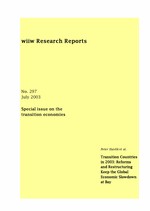Transition Countries in 2003: Reforms and Restructuring Keep the Global Economic Slowdown at Bay
Peter Havlik
wiiw Research Report No. 297, July 2003
94 pages including 29 Tables and 21 Figures
You can also download separate country reports of this report
| No. | Title | Author | |
|---|---|---|---|
| 1 | Country Report Bulgaria: economic rebound continues | Anton Mihailov | Free Download |
| 2 | Country Report Croatia: strong growth, weak external position | Hermine Vidovic | Free Download |
| 3 | Country Report Czech Republic: falling prices, rising output | Josef Pöschl | Free Download |
| 4 | Country Report Hungary: corrective measures to stop drifting | Sandor Richter | Free Download |
| 5 | Country Report Macedonia: slow recovery in sight | Vladimir Gligorov | Free Download |
| 6 | Country Report Poland: shaky economic consolidation amidst political disarray | Leon Podkaminer | Free Download |
| 7 | Country Report Romania: growing, but not yet a functioning market economy | Gabor Hunya | Free Download |
| 8 | Country Report Russian Federation: a turnaround in investments and higher GDP growth | Peter Havlik | Free Download |
| 9 | Country Report Serbia and Montenegro: entering transitional recession? | Vladimir Gligorov | Free Download |
| 10 | Country Report Slovakia: robust expansion backed by growing competitiveness | Zdenek Lukas | Free Download |
| 11 | Country Report Slovenia: suffering from poor business climate in the EU | Hermine Vidovic | Free Download |
| 12 | Country Report Ukraine: good results on several fronts | Helen Boss Heslop | Free Download |
Despite the unfavourable external economic climate over the past three years, the transition countries have displayed a reasonably good growth performance. The region as a whole has expanded more rapidly than the EU; it is also catching up in terms of productivity - especially in manufacturing. As of mid-2003, there are few signs of the protracted global economic slowdown threatening the transition countries' short- and medium-term growth prospects to any marked degree. Scheduled to join the EU in May 2004, a number of countries in Central and Eastern Europe which have attracted appreciable amounts of FDI recently improved their competitive position by securing larger export shares in the EU market. Russia continues to cash in on high revenues from energy exports; its GDP growth is accelerating while investments recover. Whereas some of the latecomers to reform and stabilization in the Balkans (Bulgaria, Romania and Croatia) have been rapidly catching up in many respects, the situation in most countries in the Western Balkans remains precarious.
The economies of the transition countries in Central and Eastern Europe will grow on average by about 3% in both 2003 and 2004 - somewhat faster than over the period 2001 2002 and outstripping the eurozone again. A slow, but steady acceleration of GDP growth is forecast for Poland. Russia and Ukraine will also experience swifter growth in 2003, only to take time out in 2004. Inflation continues to drop to single-digit annual rates throughout the region (with the exception of Romania, Serbia & Montenegro and Russia), yet it is still higher than in the eurozone (except perhaps for the Czech Republic and Poland). Unemployment displays a similar pattern. Given the current gaps in labour productivity and efficiency reserves, the present modest rates of economic growth do not make for the creation of additional jobs. Although generally quite high, current account deficits in the EU accession countries are of no immediate concern as their financing is secured via capital inflows. This is not the case in the Western Balkans; Russia and Ukraine, however, continue to enjoy current account surpluses, with Russia slowly starting to attract an increasing volume of FDI as well.
Keywords: Central and East European transition countries, forecast, East-West trade, industry, structural and technological change, exchange rates, EU enlargement
JEL classification: O52, O57, P24, P27, P33, P52
Countries covered: Bulgaria, Croatia, Czechia, Hungary, North Macedonia, Poland, Romania, Russia, Serbia and Montenegro, Slovakia, Slovenia, Ukraine, SEE, Visegrad countries
Research Areas: Macroeconomic Analysis and Policy, International Trade, Competitiveness and FDI, Sectoral studies
